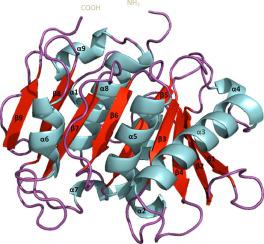Computational and Structural Biotechnology Journal ( IF 6 ) Pub Date : 2021-01-20 , DOI: 10.1016/j.csbj.2021.01.019 Yeqi Tan , Gary T. Henehan , Gemma K. Kinsella , Barry J. Ryan

|
An extracellular lipase from Amycolatopsis mediteranei (AML) with potential applications in process biotechnology was recently cloned and examined in this laboratory. In the present study, the 3D structure of AML was elucidated by comparative modelling. AML lacked the ‘lid’ structure observed in most true lipases and shared similarities with plastic degrading enzymes. Modelling and substrate specificity studies showed that AML was a cutinase with a relatively exposed active site and specificity for medium chain fatty acyl moieties.
AML rapidly hydrolysed the aliphatic plastics poly(ε-caprolactone) and poly(1,4-butylene succinate) extended with 1,6-diisocyanatohexane under mild conditions. These plastics are known to be slow to degrade in landfill. Poly(L-lactic acid) was not hydrolysed by AML, nor was the aromatic plastic Polyethylene Terephthalate (PET). The specificity of AML is partly explained by active site topology and analysis reveals that minor changes in the active site region can have large effects on substrate preference. These findings show that extracellular Amycolatopsis enzymes are capable of degrading a wider range of plastics than is generally recognised. The potential for application of AML in the bioremediation of plastics is discussed.
中文翻译:

来自地中海扁桃体的细胞外脂肪酶是一种具有塑料降解活性的角质酶
最近在本实验室中克隆并检测了一种可能在工艺生物技术中具有应用潜力的中型支链淀粉菌(AML)胞外脂肪酶。在本研究中,通过比较模型阐明了AML的3D结构。AML缺乏在大多数真正的脂肪酶中观察到的“盖子”结构,并且与塑料降解酶具有相似之处。建模和底物特异性研究表明,AML是一种角质酶,具有相对暴露的活性位点和对中链脂肪酰基部分的特异性。
AML在温和的条件下迅速水解了脂肪族塑料聚(ε-己内酯)和聚(1,4-丁烯琥珀酸酯)与1,6-二异氰酸根合己烷的混合物。已知这些塑料在垃圾填埋场中降解缓慢。聚(L-乳酸)不会被AML水解,芳香塑料聚对苯二甲酸乙二醇酯(PET)也不会被水解。AML的特异性部分由活性位点拓扑结构解释,分析表明活性位点区域的细微变化可对底物偏好产生较大影响。这些发现表明,胞外淀粉样变性酶能够降解比通常公认的更广泛的塑料。讨论了AML在塑料生物修复中的应用潜力。



























 京公网安备 11010802027423号
京公网安备 11010802027423号